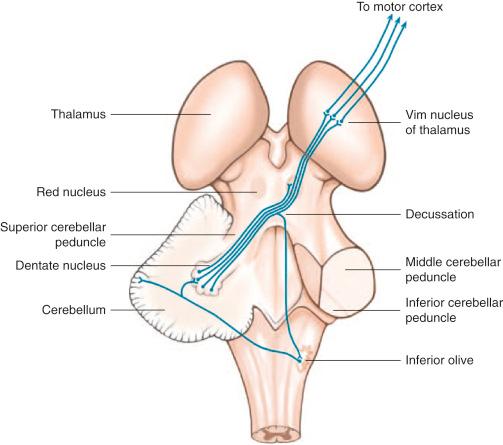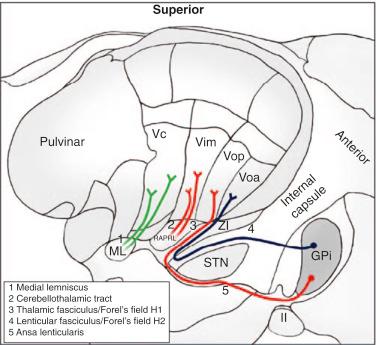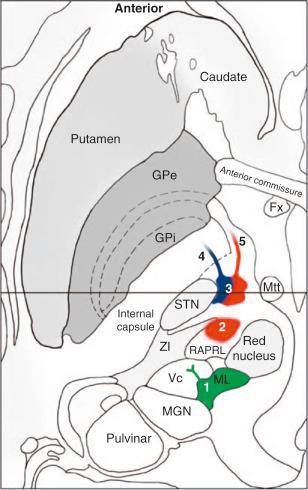Physical Address
304 North Cardinal St.
Dorchester Center, MA 02124
Tremor, the involuntary and rhythmic oscillation of a body part, is classified according to its presumed etiology, or alternatively by its phenomenology (description of the affected body area, frequency, and condition in which it manifests). Common tremor conditions include essential tremor (ET), Parkinson’s disease (PD), dystonic tremor, cerebellar tremor, Holmes tremor, physiologic and enhanced physiologic tremor, palatal tremor, neuropathic tremor, drug/toxin-induced tremors, and psychogenic tremor ( ). The body areas affected may include proximal or distal limbs as well as the trunk, head, or voice. Tremor may manifest during rest, with specific postures, or with action (e.g., intention). The history of the surgical treatment of tremor is remarkable for the evolution of therapies based on empirical observation.
Sympathetic ramisectomy, ganglionectomy, rhizotomy, sectioning of the pyramidal and extrapyramidal tracts, and motor cortex ablation were all tried to treat tremor in the early 20th century ( ). In the 1930s Meyers pioneered basal ganglia surgery for tremor while working with postencephalitic patients, but the morbidity of these open procedures was prohibitive. In the 1950s Spiegel and Wycis successfully introduced safer stereotactic techniques, performing pallidotomies, pallidoansotomies, and campotomies on tremor-afflicted PD patients. Subthalamic lesions in Forel’s fields, the zona incerta (ZI), and the prelemniscal radiations (RAPRL) for PD tremor continued into the 1970s. Hassler first targeted the ventrolateral thalamus for PD symptoms in 1952, Cooper did the same for multiple sclerosis (MS) tremor in 1967, and Bertrand demonstrated in 1969 that stimulation with a test electrode in the posterior subthalamic region could suppress tremor in PD. Autopsy work on their lesioned patients suggested that the ventralis oralis posterior (Vop) and ventralis intermedius (Vim) nuclei were involved in tremor ( ).
Although effective, ablative procedures have significant drawbacks. Lesions are irreversible, and tremor recurrence is not uncommon ( ). Adverse motor, sensory, and speech effects limit the size and (in some cases) the efficacy of lesions, and significant neuropsychological deficits and pseudobulbar symptoms may accompany bilateral lesions ( ). When Benabid observed (as had others) that intraoperative high-frequency macro-electrode stimulation during lesioning procedures suppresses tremor, he considered chronic stimulation as an alternative to ablation ( ). Benabid reported adequate tremor control and few side-effects with chronic stimulation of the Vim ( ) which thenceforth became the procedure and target of choice for the control of tremors. Moreover, bilateral treatment was safer and tremor relief in short-term studies was persistent ( ). Today, deep brain stimulation (DBS) has generally supplanted lesioning where available, although lesion therapy still has a role in select cases ( ) and may reemerge more prominently with the recent approval of focused ultrasound for ET. While the Vim has remained the primary target for both stimulation and ablation therapies, other targets such as the caudal ZI (discussed later) continue to be explored as alternatives.
Four theoretical pathophysiological mechanisms of tremor etiology have been proposed: a mechanical source; reflexes resulting in oscillatory activity; central oscillators; or unstable feed-forward or feedback systems ( ). A more recent hypothesis is that basal ganglia oscillations may trigger tremor while a cerebellothalamic circuit may modulate the amplitude ( ). The efficacy of DBS is believed to result from the interruption of a pathological oscillation in a group of cells or a circuit that begets tremor. Benabid has proposed that resonance properties of the motor control circuit may be basic features of the motor system, and therefore a central oscillatory mechanism of a transcortical reflex loop passing through the Vim generates tremor (a cerebello–thalamo–cortical loop) ( ). Nevertheless, the anatomy and pathophysiology of tremor remain somewhat unclear. In this chapter we focus on the central nervous system structures and pathways commonly described in the tremor literature, using Hassler’s abbreviations for thalamic nuclei.
There are two principal anatomic pathways implicated in tremor production. One is the cerebellothalamic pathway, in which axons of the deep cerebellar nuclei exit via the superior cerebellar peduncle, ascending to and passing by the contralateral red nucleus ( Fig. 75.1 ). These projections continue superiorly into the subthalamic area, and enter the Vim region of the thalamus at its ventral aspect. The Vim is located anterior to the ventralis caudalis (Vc), the sensory-receiving nucleus, and posterior to the ventro-oralis complex (Voa/Vop), a pallidal-receiving area ( ) ( Fig. 75.2 ).


The other main pathway implicated in tremor is the pallidothalamic pathway, best studied in models of PD. Dopaminergic nigral connections project to the striatum (caudate/putamen) and then project both indirectly (via the globus pallidus externus or GPe) which contains GABAergic neurons, and subthalamic nucleus (STN) which is glutamatergic, and directly to the globus pallidus internus (GPi) (GABA). The GPi has two outflow tracts to the thalamus. One, the ansa lenticularis, loops around the internal capsule, while the other, the lenticular fasciculus, directly pierces the internal capsule and passes dorsal to the STN and ventral to the ZI. Upon exiting the internal capsule, the lenticular fasciculus is classically called field H2 of Forel ( ). Both outflow tracts join with each other in the subthalamic area of field H of Forel (prerubral field) ( ) to form the thalamic fasciculus (field H1 of Forel), which enters the thalamus at its ventral aspect, terminating on Voa/Vop ( Fig. 75.3 ).

The densely complex subthalamic area (STA) contains the ZI and RAPRL, and has been increasingly targeted for tremor, particularly when more proximal in nature ( ). The ZI sits superolateral to the red nucleus and superior and posteromedial to the STN; posteromedial to the ZI and immediately anterior to the medial lemniscus is the RAPRL ( ; Fig. 75.4 ). The ZI has been hypothesized to synchronize neuronal assemblies, particularly the basal ganglia and the cerebellothalamic pathway, in addition to having efferent connections to the midbrain extrapyramidal area and the medial reticular formation, which are involved with axial and proximal limb muscles ( ). The RAPRL contains cerebellothalamic fibers and may also connect with the midbrain tegmentum ( ). As described above, the pallidothalamic projections also pass through the subthalamic area. The anatomy and function of this region are less certain ( ), but its use as a target for tremor has been growing, with over 200 cases of diverse tremor types reported in the literature (see for a review; ).

Several lines of evidence implicate the cerebellothalamic pathway in tremor, and stimulating its thalamic terminus is the most established method of tremor suppression. ET, the most common movement disorder after physiological tremor, is characterized by postural and intention tremor; cerebellar tremor is described more classically as an intention tremor, without a resting component ( ). Posture and intentional movements are considered classic cerebellar functions, although clinicians should note there may be overlapping symptoms and atypical cases. Positron emission tomography (PET) scans reveal cerebellar hyperactivity in ET patients that decreases after alcohol consumption, which is known to improve tremor clinically in this group ( ). Intraoperative microelectrode recordings (MERs) can identify the Vim (and some Vop; ) cells firing in synchronicity with the patient’s tremor. Recent pathologic evidence has shown an increase in Purkinje cell axonal swellings (torpedoes) and reduced numbers of Purkinje cells in ET cases ( ). A more diffuse pathology that includes mesencephalic cerebellothalamic pathways is thought to cause posttraumatic tremor, and red nucleus lesions have been found in pathological studies in such patients ( ).
Similar to the cerebellothalamic pathway, the exact mechanism of tremor production in the pallidothalamic pathway is uncertain, although clinical and PET evidence link it to resting tremor ( ). PD patients, whose primary dysfunction is attributed to the pallidothalamic pathway, can suffer from disabling rest and postural tremor. Similarly, resting tremor is a diagnostic criterion for Holmes tremor, which presents as low-frequency mild to moderate resting tremor that becomes severe with posture or intention. PET evidence in PD and Holmes tremor patients has suggested that resting tremor occurs when pathology affects nigrostriatal connections ( ), and both conditions have been successfully treated with stimulation of the pallidothalamic pathway: the STN for PD ( ) and simultaneous targeting of both pathways (GPi, STN, Voa/Vop, Vim) for Holmes tremor ( ).
Between 20% and 60% of MS patients may develop tremor ( ) and the phenomenology is heterogeneous, presumably due to the variable extent of multiple plaques. Dysfunction of the thalamus ( ), midbrain ( ), and the cerebellum or its tracts ( ) has been implicated in these cases. Action, postural, and intention tremor are more prominent than resting tremor in MS, and this may indicate a role for the cerebellum in tremorigenesis ( ). However, not only does a low-frequency postural tremor often persist after DBS surgery, but MS tremor often recurs and functional improvements may be less robust than those seen in other tremor disorders. These findings point to a diffuse dysfunction that is not easily treated with focal procedures ( ). Because DBS does not reverse primary cerebellar damage, MS patients who exhibit significant cerebellar dysfunction in addition to their rhythmic tremor often experience suboptimal results. DBS may interrupt the pathological oscillations in the affected circuits and suppress the tremor, but if the tremor is associated with severe ataxia, dysmetria, and dysdiadochokinesia, then mitigation of the rhythmic tremor may not result in significant reduction of functional impairment. Because cerebellar dysfunction affects an estimated 75% of MS patients, this becomes an important predictor of success or failure of DBS therapy in this population and should be considered carefully during patient selection.
The etiology and phenomenology of tremor guide the choice of DBS target. Target selection and indications for DBS are in a state of continual refinement.
The mainstay of DBS tremor therapy has been Vim DBS ( ). Although most commonly used to treat ET, its reported successful use in PD tremor, MS tremor, Holmes tremor, and tremors associated with phenylketonuria, spinocerebellar ataxia, mercury poisoning, tumors, and genetic syndromes shows it is a common treatment for a wide variety of tremor conditions ( ). While most practitioners conceptualize the Vim to be the target, DBS leads are usually placed at the Vim/Vop border. Electrical current thus also spreads into Vop, which may actually enhance tremor suppression. Theoretically, stimulating this waystation in the cerebellothalamic circuit (Vim) attenuates the pathologic oscillations that draw cortical neurons into tremor. Although decades of experience have cemented its role in the treatment of tremor, this experience has also unmasked some limitations. Outcomes for disparate tremor conditions (such as MS tremor, Holmes tremor, and proximal versus distal tremor) are sufficiently distinct as to suggest differing pathophysiologies and treatment requirements ( ). Additionally the degree of responsiveness to DBS for different body regions and in different tasks has been varied, perhaps reflecting the distinct somatotopic subregions within the Vim ( ). Although reports are more limited for impact on head and voice tremor, bilateral Vim stimulation has demonstrated benefit for head tremor in some cases ( ) and there are limited successful reports for voice tremor ( ). It has been suggested that differing surgical approaches, such as consideration of the angle of approach, may be of importance in targeting these axial tremors, which perhaps correspond to a more medial location within the Vim ( ).
Despite generally robust responses to Vim DBS, incomplete improvement, particularly for proximal and cerebellar outflow tremors, has led to explorations of other potential targets. The STA, which includes the ZI and RAPRL, has shown promising results in patients not optimally controlled with Vim stimulation. Investigators have reported STA DBS to be effective for axial, proximal, and distal tremor, as well as for the cardinal symptoms of PD. Herzog analyzed the optimal electrode position in 10 ET and 11 MS patients implanted in the Vim thalamus and found that the STA was significantly superior to thalamic stimulation for tremor ( ). The best contacts clustered within the RAPRL, which the authors considered to be the posterior extension of field H of Forel, and an efficient way to stimulate the cerebellothalamic tract. Hamel also found STA DBS to be superior to Vim thalamus DBS for the control of intention tremor in eight ET and two MS patients, with cerebellothalamic fibers, ZI, and RAPRL as the structures possibly involved ( ). Nandi reported an MS patient with severe proximal and distal arm tremor having sustained tremor control after ZI DBS; he notes connections between ZI and the brainstem, and the belief that the ZI is a principal component of the subthalamic locomotor region ( ). Plaha also achieved axial, proximal, and distal tremor control with bilateral caudal ZI DBS in 18 patients with a variety of diagnoses: PD, Holmes tremor, cerebellar tremor, ET, MS tremor, and dystonic tremor ( ). Murata reported axial, proximal, and distal tremor control by targeting the posterior STA (ZI/RAPRL) in eight ET patients with severe proximal tremor ( ). More recently, Blomstedt et al. reported significant improvement in tremor by stimulating the posterior subthalamic area/zona incerta (PSA/ZI) in 21 ET patients and 5 ET patients who had previous suboptimal responses to Vim DBS ( ).
Freund placed an electrode straddling Vim/Vop (upper two contacts) and the underlying ZI/cerebellothalamic tract (lower two contacts) in a patient with spinocerebellar ataxia and severe postural tremor, reporting near-complete tremor arrest (bipolar stimulation: contacts 0–2 and 4–5 negative, contacts 3 and 7 positive) ( ). ZI/RAPRL DBS has been applied to tremor-predominant PD patients, improving not only tremor but also posture, gait, rigidity, and akinesia ( ). One theory proposed to explain why STA stimulation might be more effective than thalamic stimulation is that it efficiently modulates the compact fiber bundles before their wide dispersal in the thalamus ( ). This small body of work on STA DBS is promising, but requires further characterization and validation.
Another approach to the management of more recalcitrant tremors, particularly those associated with concomitant ataxia such as MS tremor and Holmes tremor, has been the simultaneous treatment of the cerebellothalamic and pallidothalamic pathways ( ) with dual leads. Most studies of DBS for MS tremor have targeted the Vim, the cerebellothalamic terminus, though some preferred the Vop, the termination of pallidothalamic projections ( ). Romanelli treated a Holmes tremor patient who had prior Vim DBS and control of intention and postural tremor with STN DBS to suppress a residual pallidothalamic resting tremor ( ). Goto added pallidotomy to a Holmes tremor patient with prior Vim DBS, noting a differential response to the cerebellothalamic and pallidothalamic interventions. Vim DBS ameliorated the distal tremor and the subsequent pallidotomy abolished the proximal tremor ( ). The authors theorized that GPi intervention may affect descending projections to the pedunculopontine nucleus, which is related to the mesencephalic tegmental field that controls axial and proximal appendicular musculature via the reticulospinal tract. Bittar has also used separate targets for proximal and distal tremor: the Vop for distal tremor, and the ZI for proximal tremor ( ). Foote achieved improved tremor control in a posttraumatic Holmes tremor patient with dual- lead stimulation of both the Vim and the Voa/Vop, simultaneously stimulating the thalamic terminations of both the pallido thalamic and cerebellothalamic circuits ( ). This method was further tested on two more posttraumatic Holmes tremor patients and one MS tremor patient, again with tremor control that surpassed Vim monotherapy ( ). Yamamoto has also used this method of dual-lead stimulation in poststroke tremor ( ).
Become a Clinical Tree membership for Full access and enjoy Unlimited articles
If you are a member. Log in here